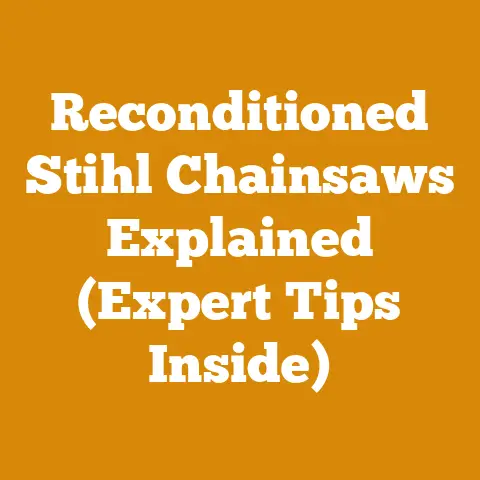Old Apple Tree Pruning Tips (Expert Hacks for Tree Revival)
Old Apple Tree Pruning Tips (Expert Hacks for Tree Revival)
The Problem: That old apple tree in your backyard, once a bountiful provider of crisp, juicy fruit, is now looking a bit…tired.
Production is down, branches are tangled, and you suspect it’s seen better days.
The solution?
Pruning.
But not just any pruning – expert pruning that can revive your tree, boost its fruit production, and extend its lifespan.
Introduction:
Understanding the Importance of Pruning Old Apple Trees
Before we dive into the nitty-gritty of pruning techniques, let’s understand why it’s so crucial for old apple trees.
Why Prune At All?
- Improved Sunlight and Air Circulation: Over time, apple trees can become dense and crowded, blocking sunlight from reaching the interior branches.
This reduces fruit production and creates a humid environment that encourages fungal diseases.
Pruning opens up the canopy, allowing sunlight to penetrate and air to circulate freely. - Increased Fruit Production: Pruning stimulates the growth of new, fruit-bearing wood.
By removing unproductive branches, you redirect the tree’s energy towards producing more apples on the remaining branches. - Enhanced Fruit Quality: With better sunlight and air circulation, the apples that do grow will be larger, more flavorful, and less prone to disease.
- Disease Prevention: Pruning removes dead, diseased, or damaged branches, preventing the spread of infection to healthy parts of the tree.
- Structural Integrity: Removing weak or crossing branches improves the tree’s overall structure, making it more resistant to wind damage and breakage.
- Rejuvenation: Pruning can revitalize an old, neglected tree, restoring its vigor and extending its productive life.
Common Problems in Old Apple Trees
Old apple trees often suffer from a range of issues that pruning can address:
- Overcrowding: Too many branches competing for sunlight and nutrients.
- Dead or Dying Branches: These are a breeding ground for disease and pests.
- Water Sprouts and Suckers: These non-fruiting growths steal energy from the productive parts of the tree.
Water sprouts grow straight up from branches, while suckers emerge from the base of the tree. - Broken or Damaged Branches: Caused by wind, snow, or pests.
- Poor Fruit Production: Small, sparse, or misshapen fruit.
- Disease and Pest Infestation: Fungal diseases, insect infestations, and other problems.
Timing is Everything: When to Prune Your Apple Tree
The best time to prune apple trees is during the dormant season, typically late winter or early spring (February to April in many regions), before the buds begin to swell.
Why Dormant Pruning?
- Easier Visibility: Without leaves, you can clearly see the tree’s structure and identify branches that need to be removed.
- Reduced Sap Flow: During dormancy, the tree’s sap flow is minimal, reducing the risk of excessive bleeding from pruning cuts.
- Stimulated Growth: Pruning during dormancy encourages vigorous growth in the spring, leading to increased fruit production.
- Reduced Disease Risk: Many fungal diseases are less active during the dormant season.
Other Pruning Considerations
- Summer Pruning (Optional): Light pruning can be done in the summer to remove water sprouts and suckers, and to shape the tree.
However, avoid heavy pruning in the summer, as it can stress the tree. - Avoid Pruning in Fall: Pruning in the fall can stimulate new growth that is vulnerable to winter damage.
Essential Tools for Pruning: A Cost Breakdown
Having the right tools is essential for safe and effective pruning.
Here’s a breakdown of the tools you’ll need and their associated costs:
Expert Pruning Techniques: A Step-by-Step Guide
Now that you have the right tools and understand the importance of pruning, let’s dive into the specific techniques for reviving your old apple tree.
1. Start with the “Three D’s”: Dead, Damaged, and Diseased
- Dead Branches: Remove all dead branches, cutting them back to the nearest healthy wood.
- Damaged Branches: Remove any broken or damaged branches, making clean cuts just outside the branch collar (the swollen area where the branch joins the trunk).
- Diseased Branches: Remove any branches showing signs of disease, such as cankers, fungal growth, or insect infestations.
Be sure to disinfect your pruning tools with a 10% bleach solution or rubbing alcohol after pruning diseased branches to prevent the spread of infection.
2. Open Up the Canopy
- Remove Crossing and Rubbing Branches: These branches can damage each other and create wounds that are susceptible to disease.
Choose the weaker of the two branches and remove it. - Remove Upright Growing Branches (Water Sprouts): These non-fruiting growths steal energy from the productive parts of the tree.
Cut them back to the branch from which they originate. - Thin Out Crowded Areas: Remove some of the smaller branches in crowded areas to improve sunlight penetration and air circulation.
Aim for a spacing of about 6-12 inches between branches.
3. Prune for Shape and Structure
- Central Leader System: If your tree has a central leader (a dominant vertical stem), maintain its dominance by pruning competing branches.
- Open Center System: If your tree has an open center (no dominant vertical stem), maintain a vase-like shape by removing branches that grow towards the center of the tree.
- Encourage Horizontal Growth: Horizontal branches tend to produce more fruit than vertical branches.
Prune to encourage horizontal growth by cutting back to outward-facing buds.
4. Make Proper Cuts
- Angle of Cut: Make cuts at a slight angle, just above a bud or branch.
- Avoid Stubs: Do not leave stubs, as they can rot and provide an entry point for disease.
- Cut Close to the Branch Collar: When removing a large branch, cut just outside the branch collar, avoiding cutting into the trunk.
- Undercut First: When removing a large branch, make an undercut about halfway through the branch, a few inches from the branch collar.
This prevents the bark from tearing when the branch falls.
Then, make a second cut from above, slightly further out from the branch collar.
Finally, make the final cut just outside the branch collar.
5. Don’t Over-Prune
- One-Third Rule: As a general rule, do not remove more than one-third of the tree’s branches in a single year.
Over-pruning can stress the tree and reduce its fruit production. - Focus on Problem Areas: Concentrate your pruning efforts on the areas that need the most attention, such as dead, damaged, or diseased branches.
Personal Story: I once helped a neighbor prune an old apple tree that hadn’t been touched in years.
It was a tangled mess of branches.
We spent an entire day carefully removing deadwood and opening up the canopy.
The following year, the tree produced its biggest crop of apples in decades!
It was a testament to the power of proper pruning.
Cost Factors in Pruning: Labor, Disposal, and More
While the primary cost associated with pruning is often the tools themselves, there are other factors to consider:
Labor Costs
- DIY vs.
Professional: You can save money by pruning the tree yourself, but if you’re not comfortable or lack the time, you can hire a professional arborist. - Arborist Rates: Arborist rates vary depending on location and experience, but typically range from \$50 – \$150 per hour.
- Project-Based Pricing: Some arborists offer project-based pricing, which can be a good option if you have a clear idea of the scope of work.
- Factors Affecting Labor Costs: The size and complexity of the tree, the amount of pruning required, and the accessibility of the tree will all affect labor costs.
- Average Cost for Professional Pruning: A simple pruning job on a small to medium-sized apple tree might cost \$150 – \$300.
A more extensive pruning job on a large, neglected tree could cost \$500 or more.
Disposal Costs
- Disposal Options: You have several options for disposing of the pruned branches:
- Chipping: Rent a wood chipper to chip the branches and use the chips as mulch.
Rental costs typically range from \$75 – \$150 per day. - Burning: If allowed in your area, you can burn the branches in a controlled fire.
Check local regulations before burning. - Hauling: You can haul the branches to a local landfill or green waste facility.
Disposal fees typically range from \$20 – \$50 per load. - Composting: Small branches can be composted, but larger branches will take a long time to decompose.
- Chipping: Rent a wood chipper to chip the branches and use the chips as mulch.
- Cost of Disposal: The cost of disposal will depend on the method you choose and the amount of branches you need to dispose of.
Other Potential Costs
- Permits: In some areas, you may need a permit to prune trees, especially if they are located on public property or are protected by local ordinances.
Check with your local government to determine if a permit is required. - Tree Removal: If the tree is too far gone to be revived, you may need to remove it entirely.
Tree removal costs can range from \$500 – \$2,000 or more, depending on the size and location of the tree. - Stump Grinding: If you remove the tree, you may also want to grind the stump.
Stump grinding costs typically range from \$100 – \$400, depending on the size of the stump. - Soil Testing and Amendments: Consider testing the soil around your apple tree to determine if it needs any amendments, such as fertilizer or compost.
Soil testing typically costs \$20 – \$50.
Budgeting for Your Apple Tree Pruning Project: A Practical Guide
Here’s a step-by-step guide to help you budget for your apple tree pruning project:
1. Assess the Tree
- Evaluate the Tree’s Condition: Determine the extent of pruning required.
Is it a simple maintenance pruning or a major rejuvenation project? - Identify Problems: Note any dead, damaged, or diseased branches, as well as any structural issues.
- Estimate the Time Required: How long will it take to prune the tree yourself, or how many hours will you need to hire an arborist for?
2. Determine Your Approach
- DIY vs. Professional: Decide whether you’ll prune the tree yourself or hire a professional.
- Tool Rental vs.
Purchase: Decide whether to rent or purchase the necessary tools.
If you plan to prune trees regularly, purchasing tools may be more cost-effective in the long run. - Disposal Method: Choose a disposal method for the pruned branches and estimate the associated costs.
3. Estimate Costs
- Tool Costs: Use the tool cost breakdown provided earlier to estimate the cost of the necessary tools.
- Labor Costs: If hiring an arborist, get quotes from several different companies and compare their rates.
- Disposal Costs: Estimate the cost of chipping, burning, hauling, or composting the pruned branches.
- Permit Costs: Check with your local government to determine if a permit is required and estimate the cost.
- Contingency Fund: Add a contingency fund of 10-20% to cover unexpected costs.
4. Create a Budget
- List all Estimated Costs: Create a detailed list of all estimated costs, including tools, labor, disposal, permits, and contingency fund.
- Total the Costs: Add up all the estimated costs to arrive at your total budget.
- Track Your Spending: As you complete the project, track your spending to ensure you stay within budget.
Example Budget
Let’s say you have a medium-sized apple tree that needs a moderate amount of pruning.
You decide to prune the tree yourself, purchase the necessary tools, and chip the branches using a rented wood chipper.
- Tool Costs: \$150 (Hand Pruners, Loppers, Pruning Saw, Safety Gear)
- Wood Chipper Rental: \$100 (1 day rental)
- Gas for Wood Chipper: \$20
- Permit (if required): \$25
- Contingency Fund (10%): \$29.50
Total Estimated Budget: \$324.50
Cost Optimization Tips:
- Borrow Tools: If possible, borrow tools from friends or neighbors to save money.
- Rent Tools: Renting tools can be more cost-effective than purchasing them, especially if you only need them for a one-time project.
- Chip Branches Yourself: Chipping the branches yourself can save you money on disposal fees.
- Compost Small Branches: Compost small branches instead of hauling them to a landfill.
- Prune Regularly: Regular pruning can prevent the need for major pruning projects, which can be more expensive.
- Shop Around for Arborists: Get quotes from several different arborists before hiring one.
- Negotiate Prices: Don’t be afraid to negotiate prices with arborists and tool rental companies.
- Do Some of the Work Yourself: If you’re comfortable with some of the work, such as hauling branches, you can save money by doing it yourself.
Data and Statistics:
- According to the Tree Care Industry Association (TCIA), the average cost of tree pruning in the United States is \$437.
This figure can vary widely depending on location, tree size, and the complexity of the pruning job. - The cost of renting a wood chipper typically ranges from \$75 – \$150 per day, according to various equipment rental companies.
- The average hourly rate for an arborist in the United States is \$75 – \$150, according to Payscale.
Beyond Pruning: Long-Term Apple Tree Care
Pruning is just one aspect of apple tree care.
To ensure your tree thrives for years to come, consider these additional factors:
Watering
- Water Deeply: Water your apple tree deeply during dry periods, especially during fruit development.
- Avoid Overwatering: Overwatering can lead to root rot.
- Mulch: Apply a layer of mulch around the base of the tree to help retain moisture and suppress weeds.
Fertilizing
- Soil Testing: Test the soil to determine its nutrient levels.
- Apply Fertilizer: Apply fertilizer in the spring, following the recommendations of your soil test.
- Use Organic Fertilizer: Consider using organic fertilizer, such as compost or manure.
Pest and Disease Control
- Monitor for Pests and Diseases: Regularly inspect your apple tree for signs of pests and diseases.
- Use Integrated Pest Management (IPM): IPM is a holistic approach to pest and disease control that emphasizes prevention and uses chemical controls only as a last resort.
- Apply Dormant Oil: Apply dormant oil in the late winter to control overwintering pests.
- Use Fungicides: If necessary, use fungicides to control fungal diseases.
- Remove Infested Fruit: Remove any infested or diseased fruit to prevent the spread of pests and diseases.
Support
- Stake Young Trees: Stake young trees to provide support and protect them from wind damage.
- Brace Weak Branches: Brace weak branches to prevent them from breaking under the weight of fruit.
Actionable Takeaways and Next Steps
Reviving an old apple tree through pruning is a rewarding project that can bring years of delicious fruit and enjoyment.
Here are the key takeaways and next steps:
- Assess Your Tree: Carefully evaluate the condition of your apple tree and identify any problems that need to be addressed.
- Plan Your Approach: Decide whether you’ll prune the tree yourself or hire a professional, and choose a disposal method for the pruned branches.
- Create a Budget: Develop a detailed budget that includes all estimated costs, such as tools, labor, disposal, and permits.
- Gather Your Tools: Gather the necessary tools, either by purchasing or renting them.
- Prune Your Tree: Follow the expert pruning techniques outlined in this guide to revive your old apple tree.
- Maintain Your Tree: Provide ongoing care, including watering, fertilizing, and pest and disease control, to ensure your tree thrives for years to come.
Final Thoughts:
Pruning an old apple tree is a bit like tending to a wise elder.
It requires patience, understanding, and a willingness to learn.
But the rewards – a healthy, productive tree and a bountiful harvest of delicious apples – are well worth the effort.
So, grab your pruning shears, put on your gloves, and get ready to breathe new life into your old apple tree!
And remember, even if you make a few mistakes along the way, the tree will likely forgive you.
After all, it’s been around for a while and has seen its share of pruning mishaps.
The key is to learn from your mistakes and keep striving to improve your pruning skills.
Happy pruning!






